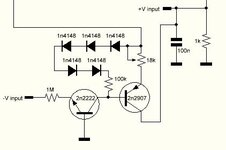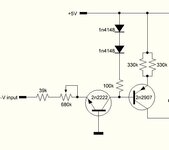crutschow
Advanced Member level 6
- Joined
- Feb 22, 2012
- Messages
- 4,460
- Helped
- 999
- Reputation
- 1,996
- Reaction score
- 1,123
- Trophy points
- 1,393
- Location
- Colorado USA Zulu -7
- Activity points
- 25,283
Are all your resistor values the exact same as in my simulation in post #19?I noticed that in your circuit, I had to place 5 diodes in series in order to bring the min voltage to -1v (at full range).

